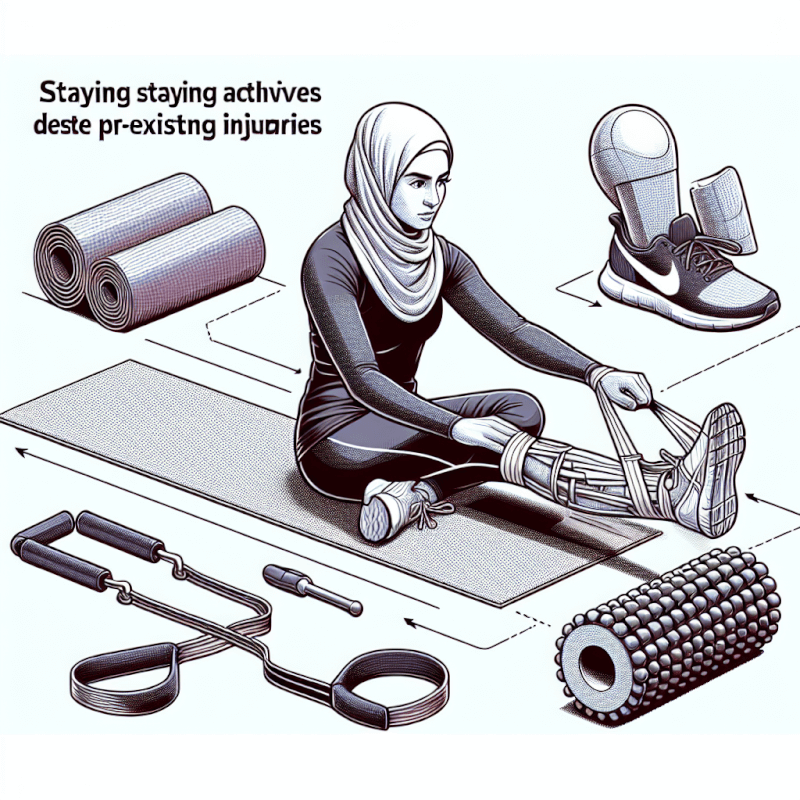Do you find yourself struggling to stay active due to pre-existing injuries? It can be frustrating and discouraging when you want to maintain an active lifestyle but are constantly held back by nagging pains or limitations. However, there are ways to manage these injuries and still enjoy physical activity. By carefully selecting appropriate exercises, listening to your body’s signals, and seeking professional guidance, you can find a balance that allows you to stay active while also taking care of your pre-existing injuries. It’s all about finding what works best for you and making modifications as needed. With the right approach, you can navigate the challenges of managing pre-existing injuries and continue to enjoy an active and fulfilling life.

Understanding Pre-existing Injuries
Types of Pre-existing Injuries
When it comes to pre-existing injuries, it’s important to understand that they can come in various forms. These injuries may include chronic conditions such as arthritis, tendonitis, or previous fractures. Pre-existing injuries can also include muscle imbalances, ligament sprains, or joint instability. Understanding the specific type of injury you have is essential in developing a management plan that works for you.
The Impact of Pre-existing Injuries on Physical Activity
Pre-existing injuries can significantly impact your ability to engage in physical activity. It’s crucial to recognize that pushing through the pain and ignoring your injuries can exacerbate the problem and potentially lead to further damage. However, this doesn’t mean that you have to forgo physical activity entirely. With proper care and management, you can still stay active while taking into account your pre-existing injuries.
Consulting a Healthcare Professional
The Importance of Professional Guidance
Seeking guidance from a healthcare professional is vital when managing pre-existing injuries. While it may be tempting to self-diagnose and treat your injuries, a qualified professional can provide you with a comprehensive evaluation and personalized treatment plan. They can offer valuable advice and guidance to help you safely partake in physical activity, while minimizing the risk of exacerbating your injuries.
Choosing the Right Healthcare Professional
When it comes to choosing the right healthcare professional, it’s important to find someone who specializes in your specific type of injury. A sports medicine physician, physical therapist, or orthopedic specialist are professionals who can provide you with the expertise and knowledge necessary to manage your pre-existing injuries effectively. Be sure to do your research and seek recommendations to find the best healthcare professional for your specific needs.
Creating a Treatment Plan
Working in collaboration with your healthcare professional, it’s essential to develop a comprehensive treatment plan. This plan will likely include a combination of treatments such as physical therapy, medication, and possibly even surgical intervention if necessary. Your healthcare professional will guide you through the process and help you understand the steps needed to manage your pre-existing injuries effectively.
Managing Pain and Discomfort
Listening to Your Body
One of the most important aspects of managing pre-existing injuries is learning to listen to your body. Pay attention to any signs of pain or discomfort and modify your activities accordingly. Pushing through pain can lead to further injury and setbacks, so take the time to rest and recover when necessary.
Implementing Rest Days
Rest days are crucial for allowing your body to heal and recover from physical activity. Incorporate regular rest days into your routine to give your muscles and joints time to repair. While it’s important to stay active, it’s essential to find a balance between activity and rest to prevent overexertion and aggravation of your pre-existing injuries.
Using Heat and Cold Therapy
Heat and cold therapy can provide relief for pre-existing injuries. Applying heat can help relax muscles and increase blood flow, promoting healing and reducing pain. Cold therapy, on the other hand, can reduce inflammation and numb the area, providing temporary pain relief. Consult with your healthcare professional to determine which therapy is best for your specific injury.
Carrying out Stretching and Strengthening Exercises
Stretching and strengthening exercises can play a crucial role in managing pre-existing injuries. Gentle stretches can improve flexibility and relieve tension, while strength training can help stabilize the affected area and prevent further injury. Consult with a physical therapist to develop a customized exercise routine that targets your specific injury, ensuring proper form and safety.
Choosing the Right Activities
Low-Impact Exercises
When managing pre-existing injuries, opting for low-impact exercises can help minimize stress on your joints and muscles. Activities such as walking, swimming, or using an elliptical machine can provide cardiovascular benefits without placing excessive strain on your injured areas. These exercises can be particularly beneficial for individuals with conditions such as arthritis or joint instability.
Swimming and Water Aerobics
Swimming and water aerobics are excellent options for individuals with pre-existing injuries. The buoyancy of water reduces the impact on your joints while providing a full-body workout. The water’s resistance also helps strengthen muscles without putting excessive strain on injured areas, making it an ideal choice for those recovering from injuries or with chronic conditions.
Cycling and Stationary Biking
Cycling and stationary biking are low-impact exercises that help improve cardiovascular fitness and strengthen your leg muscles. Using a stationary bike allows you to control the intensity and resistance, making it suitable for individuals with various pre-existing injuries. This form of exercise is particularly beneficial for individuals with knee or hip injuries.
Yoga and Pilates
Yoga and Pilates offer a combination of gentle stretching, strengthening, and balance exercises. These activities focus on proper body alignment, core stability, and breath control. Modified poses and exercises can be tailored to accommodate individuals with pre-existing injuries. Consult with a qualified instructor to ensure you’re practicing poses and movements safely.
Incorporating Strength Training
Strength training can be an essential part of managing pre-existing injuries. Building muscle strength around injured areas can provide additional support and stability. When incorporating strength training, start with light weights or resistance bands and gradually increase the intensity as your body becomes stronger. Always consult with your healthcare professional or a qualified trainer to determine the appropriate exercises and modifications for your specific injuries.

Proper Warm-up and Cool-down
Importance of Warm-up Exercises
Properly warming up before physical activity is crucial, especially when dealing with pre-existing injuries. Warm-up exercises increase blood flow, loosen muscles, and prepare your body for the upcoming activity. Incorporate dynamic stretches, light aerobic exercise, and joint mobilization exercises to warm up your body and reduce the risk of further injury.
Effective Cool-down Techniques
Cooling down after physical activity allows your body to gradually return to its resting state. This can help prevent muscle stiffness and soreness. Incorporate static stretching and deep breathing techniques to promote relaxation and ensure a smooth transition from activity to rest. Cool-down exercises can also aid in the removal of waste products from your muscles, promoting faster recovery.
Modifying Activities
Listening to Your Body
When managing pre-existing injuries, it’s crucial to listen to your body’s signals and make necessary modifications to your activities. If a particular movement or exercise causes pain or discomfort, try finding alternative ways to achieve a similar goal. Understanding your limitations and modifying activities accordingly will help prevent further injury and allow you to participate in physical activity safely.
Avoiding High-Impact Movements
High-impact movements can put excessive stress on your joints and muscles, potentially aggravating your pre-existing injuries. Activities such as running or jumping may need to be avoided or modified to reduce the impact. Choose exercises that are gentle on your body and avoid abrupt or jarring movements that can exacerbate your injuries.
Using Protective Gear and Equipment
When participating in physical activity with pre-existing injuries, it’s essential to use appropriate protective gear and equipment. Wearing supportive shoes, using knee braces or compression sleeves, and utilizing wrist or ankle supports can provide added stability and protection. Consult with your healthcare professional or a qualified trainer to determine the most suitable gear and equipment for your specific injuries.

Building Core Strength and Stability
Benefits of a Strong Core
Having a strong core is essential for overall stability and posture. When managing pre-existing injuries, a strong core can provide additional support to the injured area and prevent compensatory movements that may lead to further injuries. Strengthening your core muscles can also help improve balance and reduce the risk of falls and other accidents.
Exercises to Strengthen the Core
Incorporating specific exercises to strengthen your core can be beneficial when managing pre-existing injuries. Planks, bridges, and pelvic tilts are great exercises that target the deeper abdominal and back muscles. Other exercises such as bird dogs, Russian twists, and stability ball exercises can also help engage and strengthen your core. It’s important to maintain proper form during these exercises to avoid any unnecessary strain on your injured areas.
Setting Realistic Goals
Working with Your Healthcare Professional
When managing pre-existing injuries, it’s crucial to work together with your healthcare professional to set realistic goals. Your healthcare professional can assess your current condition, provide guidance, and help you establish achievable milestones. By setting realistic goals, you can progress safely and effectively without risking further injury or setbacks.
Aligning Goals with Abilities
While it’s important to challenge yourself, it’s equally important to align your goals with your abilities and limitations. Recognize that you may need to modify or adapt certain activities to accommodate your pre-existing injuries. By choosing activities that are suited to your abilities, you can maintain an active lifestyle while minimizing the risk of exacerbating your injuries.

Maintaining Proper Form
Importance of Proper Form
Maintaining proper form during physical activity is crucial for preventing injuries and managing pre-existing ones. Improper form can put unnecessary strain on your body and potentially worsen your injuries. Focus on maintaining proper body alignment, engaging the appropriate muscles, and using correct technique to ensure you’re practicing your chosen activities in a safe and effective manner.
Seeking Help from a Trainer or Coach
If you’re unsure about proper form or technique, consider seeking assistance from a qualified personal trainer or coach. They can help assess your movements, provide guidance on correct form, and help you make necessary adjustments to prevent further injury. Working with a professional can also help you maximize the benefits of your chosen activities while minimizing the risk of aggravating your pre-existing injuries.
Overcoming Mental Barriers
Managing Fear and Anxiety
Many individuals with pre-existing injuries may experience fear and anxiety around physical activity. The fear of worsening the injury or the anxiety of experiencing pain can be overwhelming. It’s important to address these mental barriers and develop strategies to manage them. Remember that with proper guidance and modifications, you can still engage in physical activity safely and with confidence.
Building Confidence
Building confidence is essential for managing pre-existing injuries while staying active. Start by gradually increasing the intensity and duration of your activities as your injuries allow. Celebrate small achievements and set realistic goals to help build confidence in your abilities. Remind yourself of the progress you’ve made and the positive impact that physical activity has had on your overall wellbeing.
Joining a Supportive Community
Joining a supportive community can greatly enhance your journey of managing pre-existing injuries while staying active. Surround yourself with individuals who understand and empathize with your challenges. Online forums, social media groups, and local support groups can provide valuable insights, advice, and encouragement. Knowing that you’re not alone in your journey can provide comfort and motivation to keep pursuing your physical activity goals.
In conclusion, managing pre-existing injuries while staying active is a manageable feat with the right approach and support. Understanding the types of injuries, seeking professional guidance, managing pain and discomfort, choosing appropriate activities, and maintaining proper form are all crucial aspects of effectively managing pre-existing injuries. By setting realistic goals, building core strength, and overcoming mental barriers, you can maintain an active lifestyle while prioritizing your overall wellbeing. Remember to always listen to your body, seek professional guidance when needed, and surround yourself with a supportive community to ensure a safe and enjoyable journey towards health and fitness.



